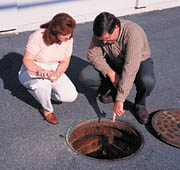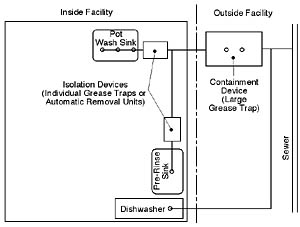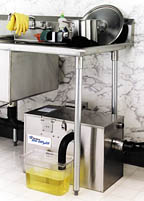
Grease separator usage originally was driven by plumbing code language seeking to protect the integrity of a facility's drainage system. However, since the late 1970s, grease separator installations have increasingly been driven by sewer district sizing requirements. In the span of 20 years, the industry has gone from passive grease traps servicing individual commercial kitchen stations to large in-ground grease interceptors receiving all kitchen flows and located between the facility and its sewer connection.
Yet, as the famous scientist Sir Isaac Newton said, "For every action there is an equal and opposite reaction." While the shift to large outside grease interceptors has been accepted as the proven means to protect sewer systems from clogs, the move away from interior grease separators servicing grease discharge points such as the primary pot-washing sinks, the pre-rinse sink at dishwashing, the wok range station or the wet-type ventilation canopy in the cooking area, has led to severe interior drainage system clogs within America's restaurant and institutional kitchen facilities. Sewer districts want no grease to enter their sewer systems where it can foul their piping and lift stations. On the other hand, facility owners are finding what is good for the sewer district is not necessarily good for their commercial kitchens.
The problem is grease congeals in pipes, and it congeals everywhere it goes. Congealed grease acts like glue. Solids such as food matter, paper and debris stick to the grease inside a facility's pipes. Ask a plumber to show you a pipe taken from a kitchen installation, and you will see a pipe filled with a soft-to-hard mass that looks like a rock collection geode with its solid layers of differing colors. The outside grease separator protects the sewer system, but the building's drainage system is unprotected and eventually succumbs to clogged pipes. When this occurs, the health and safety of the workers and customers are put at risk.

Isolation and Containment
Plumbing code officials are beginning to recognize protection of the building's plumbing system is equal to the importance of protecting their city's sewer system. You may say they are going "Back to the Future" and allowing point-source separators to service grease discharging plumbing appurtenances in the kitchen, while simultaneously requiring large outside in-ground grease interceptors to receive all kitchen flows. This is not a new notion.The late Pat Higgins, an authority on backflow and piping issues, proposed that grease separation devices be viewed with the same thinking as that used for backflow preventers. Large exterior backflow preventers are installed outside all facilities as the primary "Containment Device," which ensures that in the event the adjacent supplying city water main loses pressure, the building's water will be contained and not contaminate the city's water supply. At the same time, inside every facility, "isolation" devices are protecting the integrity of the water supply within the building. These devices include vacuum breakers on the toilet flush valves, vacuum breakers at the sinks, backflow preventers at all potable water connections to devices such as ice and drink machines, and at many other points. Pat Higgins foresaw plumbing codes adopting language permitting and/or requiring point-source grease removal separators (isolation devices) and final discharge large in-ground separators (containment devices) as a means to return plumbing codes to their original purpose: protecting building drainage system integrity.
The plumbing codes do allow for the installation of isolation devices (interior grease traps) together with an outside containment system (large in-ground grease interceptor). However, the codes usually allow the designer to take an either/or stance, with most designers electing to use large outside in-ground interceptors where sewer districts require containment grease trap systems and not installing interior isolation (point-source grease separators). The in-ground separator is viewed as meeting both the plumbing code and the sewer district's requirements. There is no concern about dealing with future interior drainage system clogs.
Frequently, a backhoe-digging contractor installs the containment separator in the ground, mounts the manhole access covers, and does the plumbing between the building and the sewer connection. If the work is not done to plumbing code standards, serious future problems can occur. This author has seen numerous installations where the inlet invert and the outlet invert were the wrong centerline heights, or the piping away from the grease interceptor was not properly sloped. If digging contractors are to continue with installing large plumbing containment devices, state and local administrative authorities should be encouraged to implement certification and training requirements to help ensure these large devices are plumbed according to the appropriate plumbing code.

A Troubling Story
Commercial kitchen facilities have an average lifespan of 25 to 35 years. The potable water plumbing inside these facilities usually lasts the entire lifespan. Understandably, mechanical appurtenances such as flush valves may be replaced or rebuilt several times during the facility's lifetime. However, because of the corrosive nature of grease deposits (some grease naturally breaks down into fatty acids), and the continual build-up of grease-glued solids deposits, it is quite common for the drainage system to experience numerous major clogging stoppages, as well as large scale piping replacement, several times during the building's natural lifespan.About 15 years ago there was a 40-plus-story bank headquarters building that had a swanky restaurant club on the top floor. One weekend, this club was hosting a large wedding reception, and the kitchen experienced a massive drainwater backup. The restaurant manager called his servicing plumbing company. The servicing plumber and his apprentice immediately set about clearing the drain clog with their snake-rooting tool. They pushed their snake pipe cleaner a long way down the pipe and felt what appeared to be the clog point. They pushed their snake through the clog, and all the drains in the kitchen immediately drained. The restaurant went back to business. The next Monday morning, the chief executive officer of the bank got to his office early and discovered sewage running down onto his expensive desk and on down the hall. The entire weekend's kitchen flows had come through his office!
What happened? Instead of reaching the clog point, the snake had penetrated through a corroded cast iron elbow, which allowed the kitchen flows to immediately drain. Had the facility had proper point-source grease separators installed and an on-going grease trap cleaning program, this calamity would never have happened.

In closing, the isolation and containment model code language has served the plumbing industry well regarding potable water system design and backflow prevention. The use of isolation and containment design thinking for commercial kitchen drainage system design is a growing trend and will be seen as an accepted plumbing practice during the next decade.